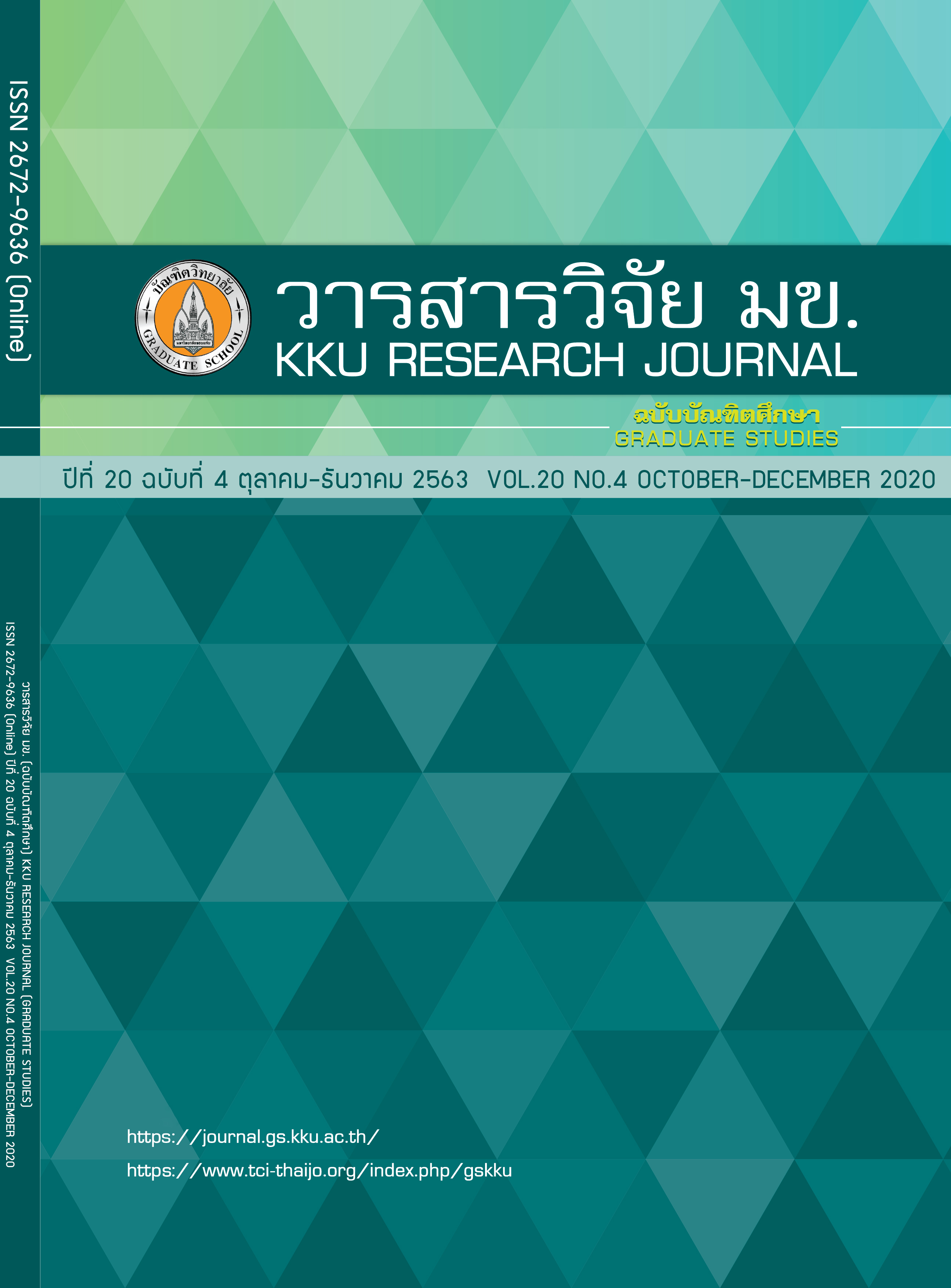Efficiency of Bio-oil Production from Napier Grass Using Circulating Fluidized Bed Reactor with Bio-oil Scrubber
Keywords:
Bio-oil production, Fast pyrolysis, Napier grassAbstract
This work is to study the efficiency of bio-oil production with and without bio-oil scrubber in a circulating fluidized bed reactor. Napier grass was used to be a raw material for pyrolysis process. The experiment was performed at biomass feed rate of 45, 60, and 75 kg/h, the temperature from 440°C to 520°C and the superficial velocity of 7 m/s. The effect on temperature and feed rate of the pyrolysis process, bio-oil properties, cold efficiency and energy conversion were studied. The experimental results show that the maximum yield of pyrolysis oil with and without bio-oil scrubber were 44.60wt% and 43.73wt%, respectively. The properties of bio-oil were investigated and it was found that the Higher Heating Valuer (HHV), cold efficiency and energy conversion in this system were 12.29 MJ/kg, 29.94%, and 20.66%, respectively. The bio-oil scrubber can improve the bio-oil production with the increasing of bio-oil yield of 1.99% compared with the system without bio-oil scrubber and it can solve the problem in fluidized bed reactor.
References
Bridgwater AV, et al. An overview of fast pyrolysis of biomass. Org. Geochem. vol. 30. no. 12. pp. 1479-1493. 1999.
Bridgwater AV, Peacocke GVC. Fast pyrolysis processes for biomass. Renew. Sustain. energy Rev. vol. 4. no. 1. pp.1-73, 2000.
Al Arni S. Comparison of slow and fast pyrolysis for converting biomass into fuel. Renew. Energy. vol. 124.pp. 197-201, 2018.
Wang X, Jia J. Effect of heating rate on the municipal sewage sludge pyrolysis character. Energy Procedia. vol. 14. no. 2011. pp. 1648-1652. 2012.
Angin D. Effect of pyrolysis temperature and heating rate on biochar obtained from pyrolysis of safflower seed presscake. Bioresour. Technol.vol. 128. pp. 593-597. 2013.
Ibrahim N, Jensen PA, Johansen DM, Ali RR, Kasmani MR. Influence of Reaction Temperature and Water Content on Wheat Straw Pyrolysis. World Acad. Sci. Eng. Technol. vol. 6. no. 10. pp. 10–21. 2012.
Adams P, Bridgwater T, Lea-Langton A, Ross A, Watson I. Biomass Conversion Technologies. Report to NNFCC. Elsevier Inc., 2017.
Pincam T, Brix H, Eller F, Jampeetong A. Hybrid Napier grass as a candidate species for bio-energy in plant-based water treatment systems : Interactive effects of nitrogen and water depth. Aquat. Bot. vol. 138. pp. 82–91. 2017.
Haegele MT, Arjharn W. The effects of cultivation methods and planting season on biomass yield of Napier grass (Pennisetum purpureum Schumach.) under rainfed conditions in the northeast region of Thailand. F. Crop. Res.vol. 214. no. July. pp. 359–364. Dec. 2017.
Lee MK, Tsai WT, Lin SH. Pyrolysis of napier grass in an induction-heating reactor. J. Anal. Appl. Pyrolysis. vol. 88. no. 2. pp. 110–116. 2010.
Yakub L, Abdalla Y, Yusup S, Kabir F. Valorization of Napier grass via intermediate pyrolysis: Optimization using response surface methodology and pyrolysis products characterization. J. Clean. Prod. vol. 142. pp. 1848–1866. 2017.
Singbua P, Treedet W, Duangthong P, Seithtanabutara V, Suntivarakorn R. Bio-Oil Production of Napier Grass by Using Rotating Cylindrical Reactor. Energy Procedia. vol. 138. pp. 641–645. 2017.
Onay O. Influence of pyrolysis temperature and heating rate on the production of bio-oil and char from safflower seed by pyrolysis, using a well-swept fixed-bed reactor. Fuel Process. Technol. vol. 88. no. 5. pp. 523–531. 2007.
Pattiya A, Suttibak. Production of bio-oil via fast pyrolysis of agricultural residues from cassava plantations in a fluidised-bed reactor with a hot vapour filtration unit. J. Anal. Appl. Pyrolysis. vol. 95. pp. 227–235. 2012.
Asadullah M, et al. Jute stick pyrolysis for bio-oil production in fluidized bed reactor. Bioresour. Technol. vol. 99. no. 1. pp. 44–50. 2008.
Asadullah M, Rasid, Kadir, and Azdarpour A. Production and detailed characterization of bio-oil from fast pyrolysis of palm kernel shell. Biomass and Bioenergy. vol. 59. pp. 316-324. 2013.
Asadullah M, et ,al. Production of bio-oil from fixed bed pyrolysis of bagasse. Fuel. vol. 86. no. 16. pp. 2514–2520, 2007.
Zhang L, Zhu L, Zhu X. Preparation of multipurpose bio-oil from rice husk by pyrolysis and fractional condensation. J. Anal. Appl. Pyrolysis. vol. 131. no. November 2017. pp. 113-119. 2018.
Tumbalam Gooty A , Berruti, Briens C. Kraft-lignin pyrolysis and fractional condensation of its bio-oil vapors. J. Anal. Appl. Pyrolysis.vol. 106. pp. 33-40. 2014.
Ji-lu Z. Bio-oil from fast pyrolysis of rice husk: Yields and related properties and improvement of the pyrolysis system. J. Anal. Appl. Pyrolysis, vol. 80. no. 1. pp. 30-35. Aug. 2007.
Suntivarakorn R, Treedet W, Singbua P, Teeramaetawat N. Fast pyrolysis from Napier grass for pyrolysis oil production by using circulating Fluidized Bed Reactor: Improvement of pyrolysis system and production cost. Energy Reports. vol. 4. pp. 565-575. 2018.
Zheng Jie Lu, ming Yi, Wang. Bio-oil production from cotton stalk. Energy Convers. Manag. vol. 49. no. 6, pp. 1724-1730. 2008.



